Author: Jake Huolihan
Despite the introduction of trendy boozy concoctions such as hard seltzer to the adult beverage market, IPA continues to receive massive amounts of attention. Whether clear and piney or hazy and juicy, what ties all types of IPA together is their pungent hop character, which is usually achieved through the use of a dry hop addition. While this is commonly done at that same temperature the beer ferments at, many brewers have been experimenting with dry hopping at cooler temperatures.
In his excellent blog post, A Case For Short And Cool Dry Hopping, commercial brewer and author, Scott Janish, lays out a number of fascinating research findings that seem to support adding dry hops to beer as cool as 34°F/1°C. Recently, this practice appears to have picked up steam, with many brewers reporting improved hop character in beers that are dry hopped at cooler temperatures.
Over the years, we’ve done three xBmts looking at the impact of beer temperature when dry hopping, only one of which returned a significant result. I’ve personally messed around with dry hopping at different temperatures, though never noticed much of a difference in my anecdotal experience. With the rising popularity of dry hopping in the keg, I began to wonder if perhaps temperature might have an impact when the hops are left in contact with the beer and designed an xBmt to test it out!
| PURPOSE |
To evaluate the differences between an American IPA dry hopped at room temperature (66°F/19°C) and one dry hopped at 36°F/2°C.
| METHODS |
I designed a simple IPA recipe for this xBmt in hopes of emphasizing any impact beer temperature during dry hop might have.
Disparate Measures
Recipe Details
| Batch Size | Boil Time | IBU | SRM | Est. OG | Est. FG | ABV |
|---|---|---|---|---|---|---|
| 5.5 gal | 30 min | 86.7 | 7.6 SRM | 1.058 | 1.01 | 6.3 % |
| Actuals | 1.058 | 1.01 | 6.3 % | |||
Fermentables
| Name | Amount | % |
|---|---|---|
| English Pale Ale (Root Shoot Malting) | 12 lbs | 80 |
| Malted White Wheat (Root Shoot Malting) | 2 lbs | 13.33 |
| Malted Oats (Root Shoot Malting) | 1 lbs | 6.67 |
Hops
| Name | Amount | Time | Use | Form | Alpha % |
|---|---|---|---|---|---|
| Loral | 30 g | 30 min | Boil | Pellet | 11.5 |
| Citra | 30 g | 15 min | Boil | Pellet | 12 |
| BRU-1 | 30 g | 5 min | Boil | Pellet | 14 |
| Citra | 30 g | 5 min | Boil | Pellet | 12 |
| Sabro | 30 g | 5 min | Boil | Pellet | 14 |
| Citra | 60 g | 5 days | Dry Hop | Pellet | 12 |
Yeast
| Name | Lab | Attenuation | Temperature |
|---|---|---|---|
| Darkness (A10) | Imperial Yeast | 75% | 32°F - 32°F |
Notes
| Water Profile: Ca 50 | Mg 0 | Na 8 | SO4 75 | Cl 36 |
Download
| Download this recipe's BeerXML file |
I made starters of Imperial Yeast A10 Darkness a day ahead of time.
I started my brew day by collecting RO water, adjusting it to my desired profile, then flipping the switch on my controller to get it heating up, after which I weighed out and milled the grain.
With the water properly heated, I mashed in then checked to ensure it was at my target temperature.
While waiting on the mash to finish, I prepared the kettle hop additions.
Once the 60 minute mash was complete, I collected the sweet wort in my kettle and proceeded to boil it with hops added as stated in the recipe.
When the boil was finished, I quickly chilled the wort with my IC.
A refractometer reading showed the wort was at my intended OG.
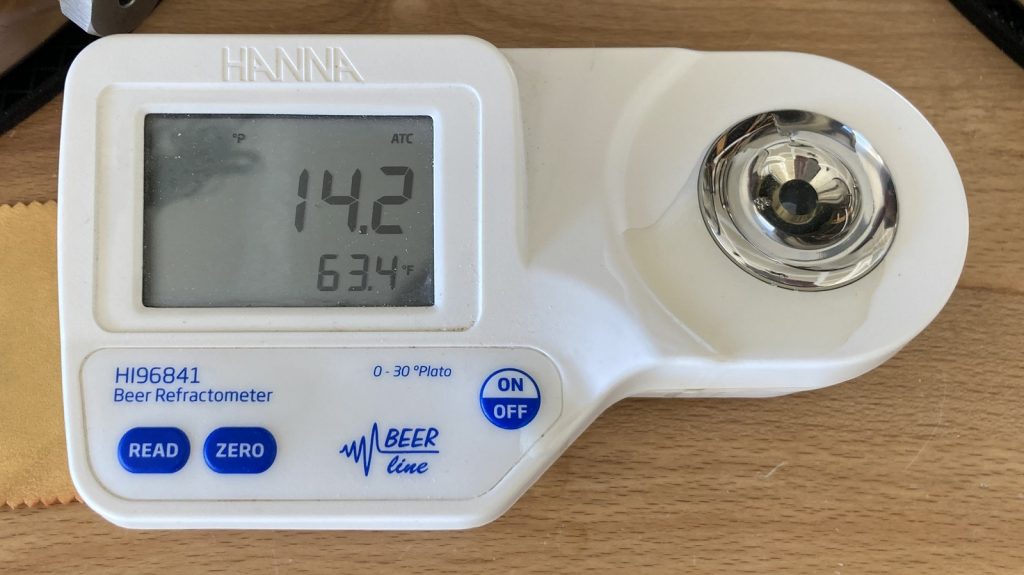
The chilled wort was then evenly split between two Brew Buckets.
Next, I used my glycol unit to finish chilling the worts to my desired fermentation temperature of 66°F/19°C before pitching the yeast. After 2 weeks, fermentation activity had dwindled in both beers so I took hydrometer measurements showing they were at the same FG.

The beers were then pressure transferred to CO2 purged kegs.
At this point, I placed one of the kegs in my 36°F/2°C keezer and the other in a closet that maintains a steady 66°F/19°C. With both beers stabilized at their respective temperatures the following day, I placed identical amounts of hops in stainless mesh filters then gently added one to each batch. The beers were left alone for 5 days before I moved the one from my closet to the keezer. After a week of conditioning on gas, both were carbonated and ready for evaluation.
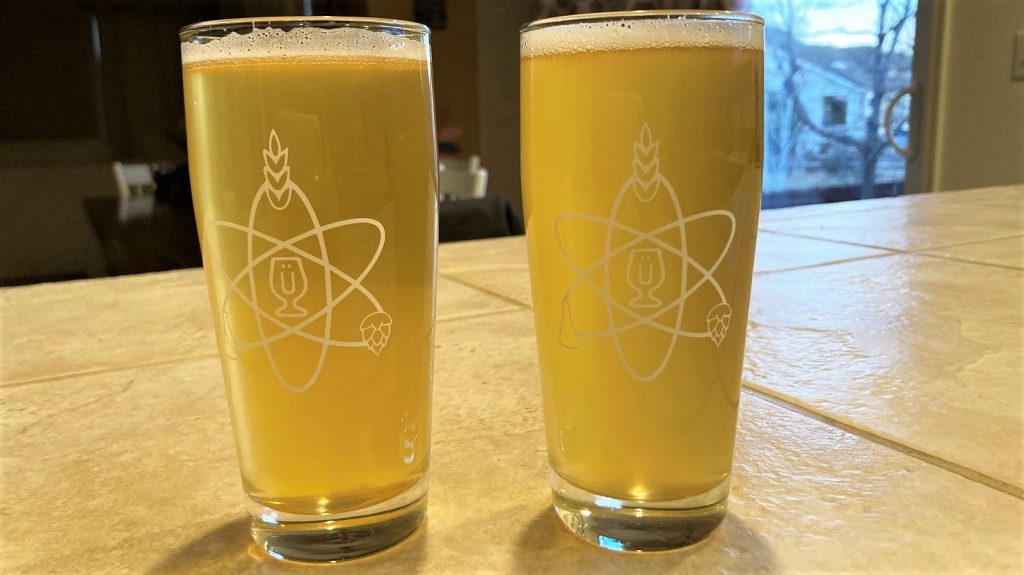
| RESULTS |
Due to social distancing practices as a result of the COVID-19 pandemic, data for this xBmt was unable to be collected in our typical manner. As such, temporary adaptations were made involving the author completing multiple semi-blind triangle tests in as unbiased a way as possible.
Utilizing 4 opaque cups of the same color where 2 were inconspicuously marked, one set was filled with the warm dry hopped beer while the other set was filled with the cold dry hopped beer. For each triangle test, 3 of the 4 cups were indiscriminately selected, thus randomizing which beer was the unique sample for each trial. Following each attempt, I noted whether I was correct in identifying the unique sample. Out of the 10 semi-blind triangle tests I completed, I needed to identify the unique sample at least 7 times (p<0.05) in order to reach statistical significance. In the end, I correctly identified the unique sample just 2 times (p=0.90), indicating my inability to reliably distinguish an American IPA dry hopped in the keg at 66°F/19°C from one dry hopped in the keg at 36°F/2°C.
In terms of aroma, flavor, and mouthfeel, I perceived these beers as being identical. However, I thought it was curious that the warm dry hopped batch was a bit clearer than the one dry hopped cool. Regardless, both beers were equally crisp, clean, and delicious!
| DISCUSSION |
For many brewers of IPA, the primary goal is to pack their beer with as much hop character as possible without it having a detrimental impact, and one way to do this involves adding hops to the fermented beer in a process known as dry hopping. While typically performed at standard ale fermentation temperatures, some have advocated for making dry hop additions once the beer has been chilled, claiming in expedites extraction while imparting desirable characteristics. My inability to reliably distinguish between a beer that was dry hopped in the keg for 5 days at 66°F/19°C from one that was dry hopped in the keg for the same amount of time at 36°F/2°C indicates any differences were minimal enough as to be imperceptible to me.
Considering the fact tasters in two past xBmts were unable to reliably distinguish between beers dry hopped at different temperatures, it’s possible any objectively measureable differences in terpene amount or quality caused by dry hop temperature are simply too small to be perceived by human tasters. However, participants in one past xBmt on this topic were able to tell apart an IPA dry hopped at 74°F/23°C from one dry hopped at 34°F/1°C, which may indicate a more noticeable impact as the temperature difference becomes vaster. Finally, there’s also a possibility that leaving the hops in contact with the wort after the initial dry hop step may have mitigated any impact of dry hop temperature, though considering modern dry hopping techniques, this seems like a less plausible explanation.
Theory vs. practice- this is what comes to mind when I think about the impact dry hopping temperature has on beer. In theory, which is supported by scientific evidence as Scott Janish so eloquently points out, dry hopping in cold beer does appear to result in less extraction of undesirable polyphenols and reduced risk of hop creep. However, in practice, it would seem any actual differences caused by dry hop temperature are likely quite low, perhaps covered up by other aspects of the beer. While I certainly remain open to the idea that dry hopping cool has benefits, I’ll continue doing what has worked wonderfully for me by adding dry hops at fermentation temperature.
If you have any thoughts about this xBmt, please do not hesitate to share in the comments section below!
Support Brülosophy In Style!
All designs are available in various colors and sizes on Amazon!
Follow Brülosophy on:
FACEBOOK | TWITTER | INSTAGRAM
If you enjoy this stuff and feel compelled to support Brulosophy.com, please check out the Support page for details on how you can very easily do so. Thanks!



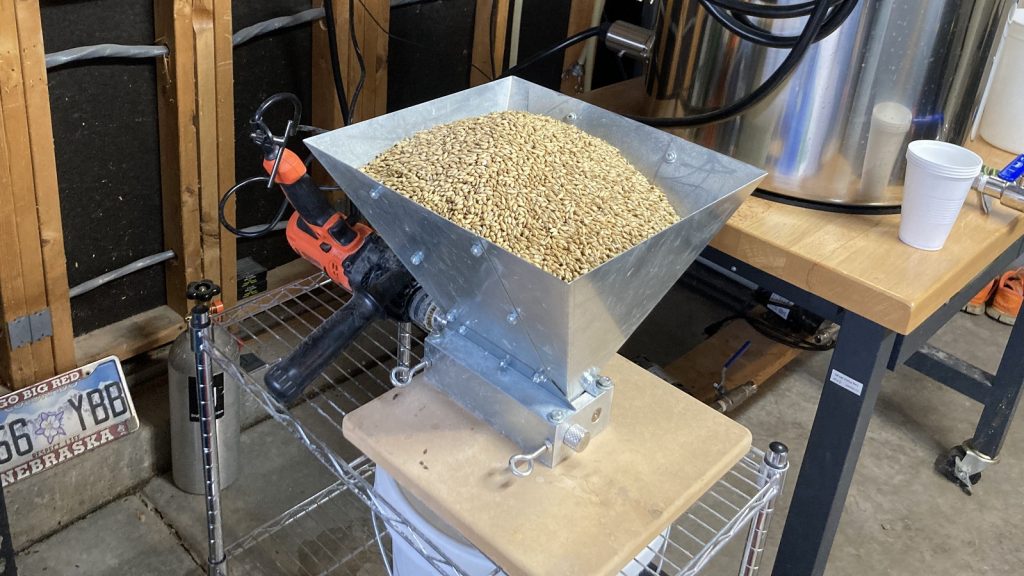
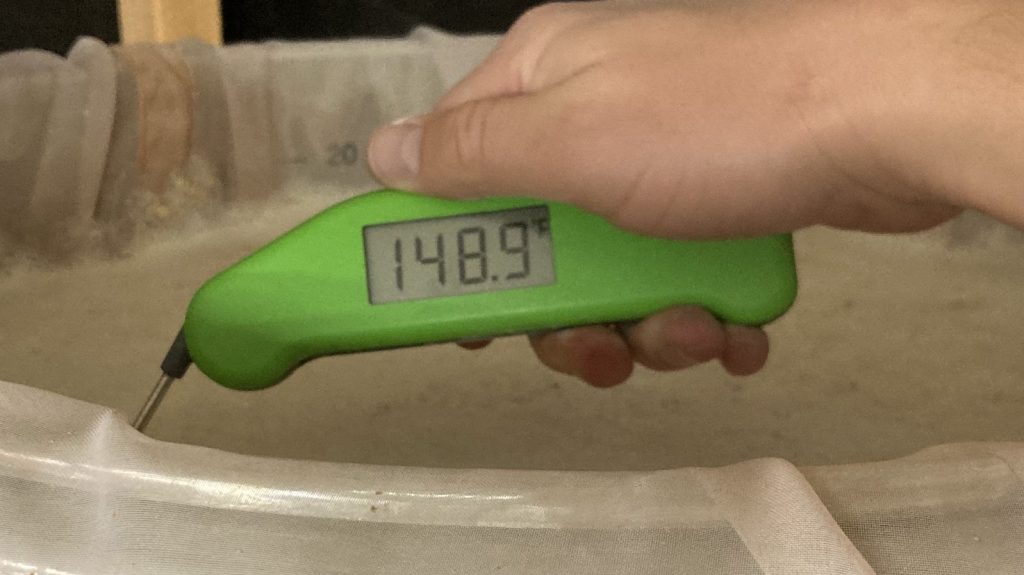
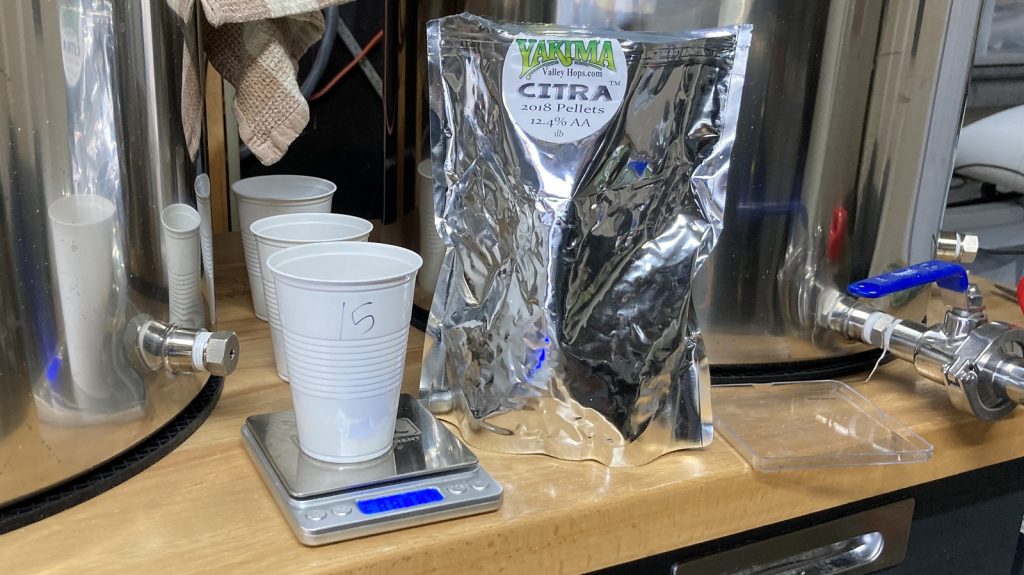
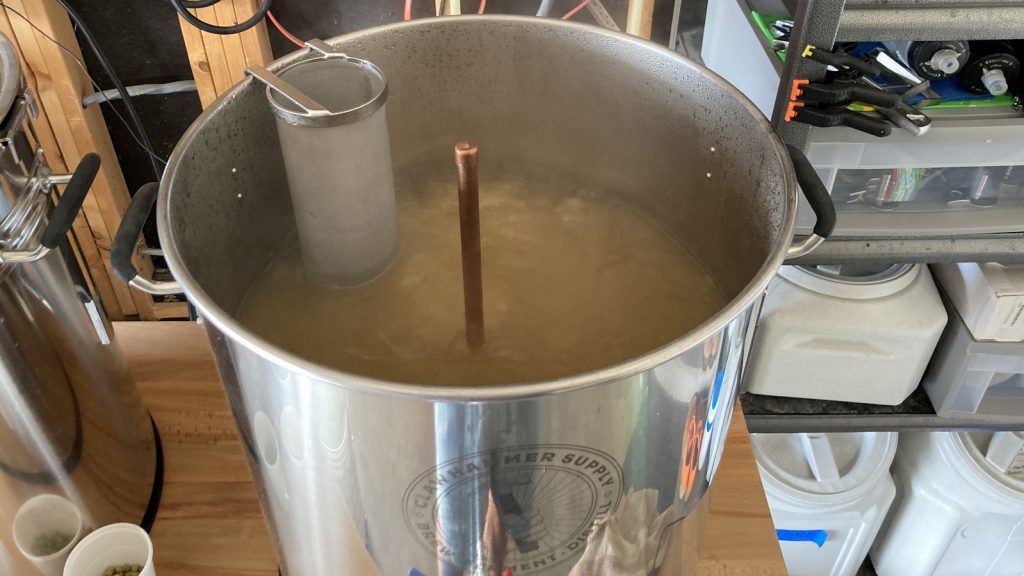
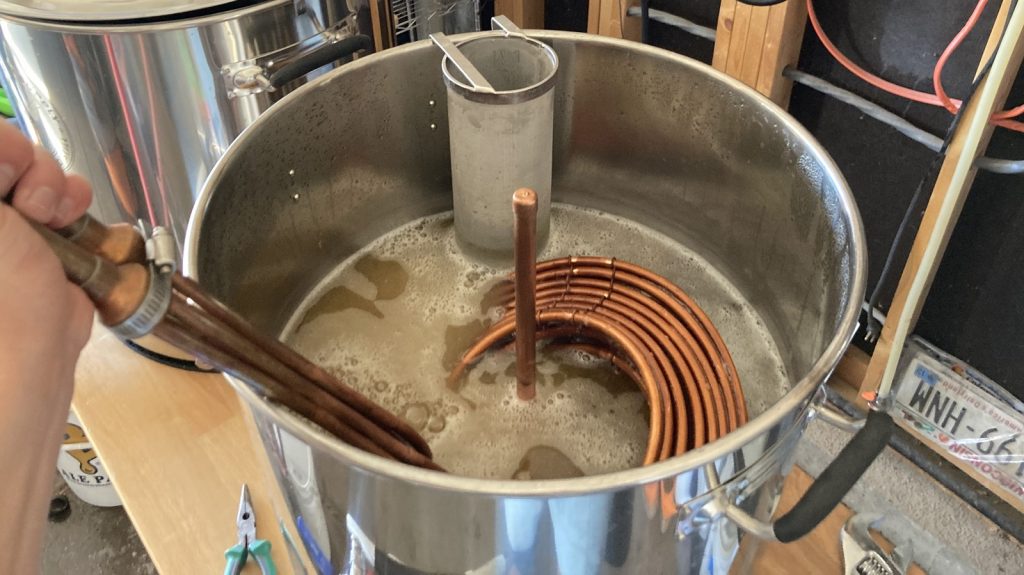













18 thoughts on “exBEERiment | Impact Of Beer Temperature When Dry Hopping An American IPA”
Did you remove the hops after 5 days, or just leave the baskets in there during the further 1 week conditioning?
Ahh, sorry. Just re-read the end there and found my answer.
Thank you Jake for this info. So it’s not perceptible, but scientific measurements (Scott) stated out a difference. Probbably on homebrew scale less of a concern. So we don’t have to worry about it, we can do what we like. Maybe for NEIPA’s there’s more into it, together with Low-oxigen brewing??!
By this info I will continue dryhopping during/end of fermentation.
Dry hopping cold increases haze though.
Perhaps if the dry hop % stood out more vs the boiled hops it would have been more pronounced. 2oz dry vs 5oz boil seems like the dry won’t really shine through in the recipe.
I think Miller is onto something here. The aroma hops could be muddying the results. I generally skip aroma hops altogether and only dry hop IPAs, always in the keg. I’ve found that the hop character in beers dry hopped cold (when the beer is already cold at kegging) is greatly suppressed compared to beers dry hopped warm — even if I immediately place the warm keg in the fridge. After a string of beers dry hopped cold, where I could barely even smell or taste it, I’ve taken to letting the keg sit out at room temp for 24 hours (to warm up from cold crashing) before placing in the fridge. This has solved the issue.
Thanks for sharing. I’m going to try dry hopping in the keg with one of the filters you mentioned.
Is it so that hopcreep is still possible even if you dryhop cold but for example bottle beers and store them in warm for some time.
I think yes- the active hops amylases will release some fermentable sugar (probably even in cold temps), and once the yeast warms up, it will ferment that sugar. Dry hopping cold shouldn’t inactivate the hops enzymes- only the boil does that.
I just read Janish’s “A Case For Short And Cool Dry Hopping” http://scottjanish.com/a-case-for-short-and-cool-dry-hopping/
He says cold & short dry hopping does reduce the likelihood of hop creep- presumably by reducing the extraction of the hops enzymes.
This requires removing the dry hops from the beer, though, which is different from what was done in this experiment.
Personally, I let my beer stay at room temp for several days after dry hopping so that the creep happens before bottling. Less concern about bottle bombs that way. I suppose if you wanted, you could do a cold & short dry hop, remove the hops, then raise the temp rise for a “hop creep” rest (5 days?), before finally priming and bottle conditioning.
The cold & short technique seems like it does not make sense for those who bottle condition and are wary of overcabonating. Warm & very short may be the way to go?
What is the copper pipe in the boil kettle for?
That is the wort chiller.
Look at the photos again. I have the same question
It’s a stand to put the chiller on to keep it off the coils.
https://jadedbrewing.com/collections/frontpage/products/the-electrichair
I own a Clawhammer and am curious as well. It’s not part of the chiller as mentioned below.
It’s the ElectriChair from JaDeD Brewing. Jake’s brewery is somewhat piecemeal, as he still prefers using his IC over a CFC.
The purported benefits are primarily from cold DH in combination with short contact time.
Scott makes an argument that monoterpene alcohols have a faster extraction rate then the monoterpens. This is something I believe he extrapolates from this paper: C. Schmidt, M. Biendl, S. Hanke, K. Reglitz and M. Steinhaus: Dry hopping potential of Eureka!, a new hop
variety. After studying this paper I believe he may have overlooked som basic elements in the paper.
But you can also flip your findings and state that a cold DH don’t have a negative impact on your (our) beer. At least you can carb your beer while dryhopping and save som time.
I do exclusively short (max 3 days) and cold (4 C ) DH and to my taste my hoppy beers turns out at least as good (I will claim them to be better) as when I did DH the “traditional way” 20C for 7 – 14 days.
The few podcasts and articles I’ve heard and read from Scott Janish seem like the biggest benefit is about flavor and shelf stability.
I would like to see the same xbmt on a NEIPA kegged and bottles that was stored for 3+ months. I think a series of triangle tests over that 3 months would be good info too.